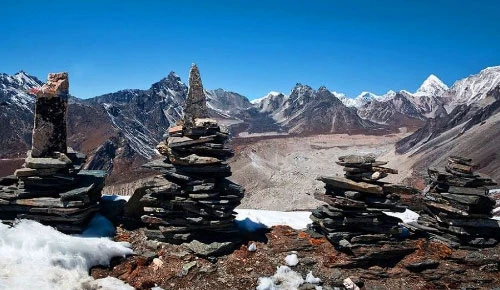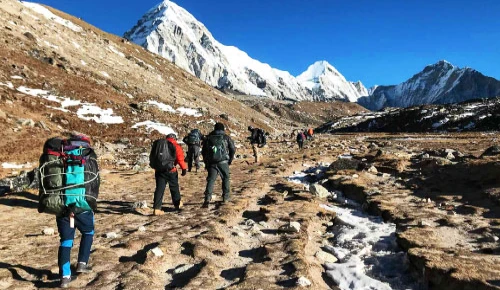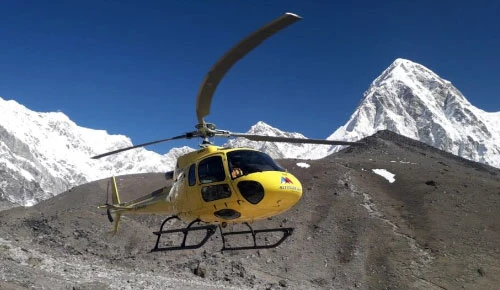History of Climbing Mount Everest
A British survey team under the direction of Sir George Everest, after whom Mount Everest was named in 1865, believed a remote Himalayan peak to be the tallest mountain in the world in 1841. Today, climbers from across the world endeavor to scale their mighty faces.
Mount Everest, alternatively known as Czomolungma in Tibetan and Sagarmatha in Nepali, is located in the Khumbu Valley. Mt.Everest has several other names, like Peak XV, Deudhunga, or 8848. The attraction of climbing to the peak of Mount Everest has drawn climbers for over a century; no matter the risks, it will continue to draw travelers for years to come.
The Everest Base Camp Trek is not just a journey through stunning landscapes and challenging terrains; it's also a journey through history. We have assembled this complete guide to Mount Everest and its climbing history. If you have ever been fascinated with Mount Everest or dreamed of climbing up Mount Everest yourself, you will find plenty of helpful and useful information in this blog.
Table of Contents
What is the height of Mount Everest?
Mount Everest is the highest peak in the world and the tallest in the Himalayan mountain range. The height of Mount Everest was first measured to be 29,002 feet (8839 m); however, it was updated in 1955 to 29,029 feet (8848.86 m), and this estimation remains today.
Where is Mount Everest located?
Mount Everest is situated in the Mahalangur mountain range and is situated on the border of both China and Nepal. The highest point of Mount Everest lies on the boundary of Nepal toward the south and Tibet (China) toward the north. The discovery of Mount Everest by George Everest and his group.
The south base camp, a popular starting point for climbers, is located in Nepal's Khumbu region, while the north base camp is in Tibet. The sheer grandeur of Everest and its challenging ascent attract climbers, trekkers, and adventurers from around the world, making it a globally recognized icon.
The History of Climbing Mount Everest
The first people to officially climb Mount Everest began their attempts in 1921. Two British Expedition team attempts in 1921 and 1922 failed to reach the summit of Mount Everest. In 1924, two members of a British expedition team, George Mallory and Andrew Irvine, were seen just before being immersed in bad weather.
In 1924, George Mallory unfortunately died along with Andrew Irivin and two Sherpas. The documentation showed that the expedition reached a height of 8,600 meters and on the next day it was supposed to take the summit and leave a picture of his wife on the summit of Mt. Everest He had been out of contact since that time.
In May 1999, the American climber Conrad Anker found the corpse of George Mallory and the things that he collected concluded that Mallory and Irvin could have reached the summit. The most important proof was the fact that Mallory's wife's picture was not found, which he promised to leave at the top Of Mt. Everest if he could take the summit. However, it is almost impossible to prove this thesis today. Someone would have to find a picture of Mallory's wife at the top of Mt. Everest. Therefore, this entry is not considered confirmed, but the history of these attempts was so great that it is impossible not to mention this while telling the story of Mt. Everest.
Sir Edmund Hillary and Tenzing Norgay Sherpa
No discussion about the Everest Base Camp Trek's history is complete without acknowledging the monumental achievement of Sir Edmund Hillary from New Zealand and Tenzing Norgay, a Sherpa from Nepal. In 1953, they became the first individuals to successfully reach the summit of Mount Everest. Climbers recorded a peak temperature of -28°C. Their conquering ascent not only made history but also paved the way for future generations of trekkers and climbers.
About Climbing Mount Everest
There are 18 different climbing routes to the top, with the South Col or the Northeast Ridge being the most popular. Though not as difficult to climb as K2 (8,611 meters, the second-highest mountain in the world), Everest has its fair share of avalanches, sudden storms, strong winds, and below-40-degree F temperatures. Many climbers struggle in the ‘Death Zone', which refers to an elevation starting at 8000 m above sea level.
The risks involved in climbing Everest are great. Even when using bottled oxygen, mountaineers can experience fatigue, nausea, vomiting, and other related problems, such as hypothermia and frostbite. Climbers normally spend months acclimatizing to get their bodies ready for the extreme conditions they will encounter.
Climbing Routes on Mount Everest
Mount Everest is located in the magnificent Himalayan mountain range. It borders two countries. Its south flank is located in Nepal, while its north flank is located in Tibet. Due to the special location, there are two main climbing routes on Mount Everest. One is from the southeast ridge in Nepal and the other is from the north ridge in Tibet. Tenzing Norgay and Edmund Hillary were the first climbers to reach the summit of Mount Everest in 1953 while the Chinese border was still closed to Westerners. They used the southeast climbing route on the Mount Everest route in Nepal.
South Col Route (Southeast Ridge)
- This route starts in Nepal and is the most commonly used by climbers.
- It begins on the south side of Everest, starting from the base camp located at around 5,364 meters (17,598 feet) above sea level.
- Climbers progress through several camps, including Camps I, II, III, and IV, which are situated at increasing altitudes.
- The route features several notable points, such as the Khumbu Icefall, the Western Cwm, the Lhotse Face, the South Col, and the Hillary Step.
- Climbers typically make summit attempts in May, during the spring climbing season, when weather conditions are most favorable.
North Col Route (Northeast Ridge)
- This route starts in Tibet (China) and is less crowded compared to the South Col Route.
- It begins on the north side of Everest, with Base Camp situated at approximately 5,150 meters (16,900 feet) above sea level.
- Climbers establish several camps as they ascend, including Intermediate Camp and Advanced Base Camp.
- Notable features along this route include the North Col, the Northeast Ridge, and the Three Steps.
- Climbers typically make summit attempts in May as well, during the spring climbing season.
Both are extremely challenging, each in its own unique way. However, the south route is believed to be technically easier to ascend, and the north side is much harder to climb because of the time spent at high altitudes, the weather and the distance traveled to reach the summit. Climbers require extensive training, experience, and proper equipment to attempt either route safely. Additionally, obtaining permits and hiring experienced guides are essential for any Everest expedition.
Death Zone
A death zone starting at 8000 m above sea level is a place where oxygen is lacking and the pressure is extremely low. People cannot survive for more than a few days. Even the use of an oxygen cylinder is not able to meet the needs of our body. Very low pressure reduces the ability to attach oxygen to hemoglobin, which brings further effects: pulmonary edema and cerebral edema. Above 8000 meters, the body survives to absorb food, so the energy balance is negative.
Tragedies and Challenges
Mount Everest has seen its fair share of tragedies, serving as a sharp reminder of the mountain's harsh reality. From avalanches to crevasses to extreme weather, many climbers have lost their lives facing these challenges. Yet, the most hurtful incident in Everest's history occurred in 1996, a moment that will never be forgotten. Eight climbers tragically perished during a fierce storm.
The tragedy had a significant impact on the climbing community, sparking discussions about ethics and safety in the mountains. It highlighted the unpredictable dangers of Everest, where a single mistake can have devastating results. Despite improvements in technology and expertise, the mountain remains a challenging opponent, requiring all climbers to approach it with reverence and care. However, the allure of reaching the summit sometimes overshadows the risks, compelling individuals to test their limits in pursuit of their aspirations.
Modern Technology and Climbing Techniques
Modern technology and innovative climbing techniques have completely changed the way climbers approach Mount Everest over the past few years. The introduction of high-tech equipment, like lightweight and strong materials, advanced weather prediction systems, and oxygen systems, has greatly improved safety and effectiveness on the mountain. Additionally, satellite communication devices have made it possible for climbers to receive instant updates and emergency help, reducing the dangers of isolation and communication problems. Advancements in medical expertise and gear have led to a decrease in altitude-related illnesses and quicker rescue missions.
Climbers are now utilizing state-of-the-art climbing methods like fixed-line ascents, ladder crossings over crevasses, and pre-set camps to enhance their chances of success. Moreover, the implementation of supplemental oxygen and high-altitude training programs has improved climbers' ability to acclimatize effectively, reducing the impact of extreme altitudes. These advancements in technology and methodology have made Everest expeditions more inclusive of a wider range of climbers while also pushing the boundaries of human achievement in high-altitude mountaineering.
Conclusion
Mount Everest represents the core of what humans dream of and work hard for. It shows how people never give up and keep going, even when faced with tough situations. It stands for the constant search for excitement and the victory of the human soul over difficult challenges. Even though there are debates and too much focus on making money from it, Everest still has a strong attraction as the ultimate challenge that requires bravery and strong will. As climbers aim to achieve more than those before them, Everest remains a shining example of humanity's unbeatable determination to conquer the highest peaks, motivating future generations.
If you're interested in the Everest region or any other part of Nepal, please don't hesitate to check out our website, Nepal Trek Adventures and Expedition. We have a variety of packages available for you to choose from. Alternatively, you can also reach us on WhatsApp at +977-9851017030. We would be delighted to help you plan and complete your tour.








